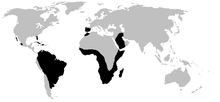Amphisbaenia
Da Wikipedia, l'enciclopedia libera.
| Amphisbaenia | |
|---|---|
 | |
| Classificazione filogenetica | |
| Dominio | Eukaryota |
| Regno | Animalia |
| Ordine | Squamata |
| Sottordine | Laterata |
| Infraordine | Amphisbaenia |
| Classificazione classica | |
| Dominio | Eukaryota |
| Regno | Animalia |
| Phylum | Chordata |
| Subphylum | Vertebrata |
| Classe | Reptilia |
| Ordine | Squamata |
| Sottordine | Amphisbaenia Gray, 1844 |
| Famiglie | |
| |
| Areale | |
 | |
Le anfisbene (Amphisbaenia Gray, 1844) costituiscono un infraordine di rettili fossori, composto da quasi 200 specie riunite in 6 famiglie[1].
Descrizione
[modifica | modifica wikitesto]Tutte le specie hanno aspetto vermiforme e ad eccezione dei Bipedidae del Messico, dotati di due arti anteriori ben sviluppati, tutte le altre specie sono apode[2].
La lunghezza delle varie specie varia da 10 a 70 cm. Il corpo è ricoperto da squame anulari. Il cranio è rigido e compatto e viene utilizzato per perforare il terreno.
Distribuzione e habitat
[modifica | modifica wikitesto]La maggior parte delle specie sono distribuite in Sudamerica e in Africa tropicale; alcune specie sono presenti in America settentrionale (Messico e Florida), nei Caraibi, in alcune aree del bacino mediterraneo (penisola iberica, Marocco, Algeria, Grecia, Asia minore e Medio Oriente) e della penisola Arabica[2].
Tassonomia
[modifica | modifica wikitesto]Il sottordine comprende le seguenti famiglie[1]:

- Amphisbaenidae Gray, 1865
- Bipedidae Taylor, 1951
- Blanidae Kearney, 2003
- Cadeidae Vidal & Hedges, 2008
- Rhineuridae Vanzolini, 1951
- Trogonophiidae Gray, 1865
Note
[modifica | modifica wikitesto]- ^ a b (EN) Taxon: Amphisbaenia, in The Reptile Database. URL consultato il 25 luglio 2018.
- ^ a b (EN) Amphisbaenia - worm lizards, in Vertebrate Diversity. URL consultato il 25 luglio 2018.
Bibliografia
[modifica | modifica wikitesto]- T. Townsend, A. Larson, E. Louis, J.R. Macey. Molecular phylogenetics of squamata: the position of snakes, amphisbaenians, and dibamids, and the root of the squamate tree. Syst Biol. 53(5), 2004, S. 735-57. (PMID 15545252)
- Fry, B. G., Vidal, N., Norman, J. A., Vonk, F. J., Scheib, H., Ramjan, S. F. R., Kuruppu, S., Fung, K., Hedges, S. B., Richardson, M. K., Hodgson, W. C., Ignjatovic, V., Summerhayes, R. & Kochva, E., Early evolution of the venom system in lizards and snakes. Nature: 2006, 439, 584-588.
Voci correlate
[modifica | modifica wikitesto]Altri progetti
[modifica | modifica wikitesto] Wikizionario contiene il lemma di dizionario «anfisbena»
Wikizionario contiene il lemma di dizionario «anfisbena» Wikimedia Commons contiene immagini o altri file su anfisbena
Wikimedia Commons contiene immagini o altri file su anfisbena Wikispecies contiene informazioni su anfisbena
Wikispecies contiene informazioni su anfisbena
Collegamenti esterni
[modifica | modifica wikitesto]- Scheda tassonomica su ITIS, su itis.gov.
| Controllo di autorità | J9U (EN, HE) 987007294060005171 |
|---|
Text is available under the CC BY-SA 4.0 license; additional terms may apply.
Images, videos and audio are available under their respective licenses.

